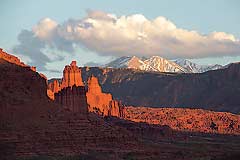When I put on private workshops I spend a lot of time talking about what makes a photograph stand out. There are many “tricks” photographers can use to give their pictures a boost. This month I’m going to try something a little different.
Instead of showing a selection of pictures, I am going to focus on just one and use it as an example to give my readers a “mini-workshop” on landscape photography.
My example is a picture I made recently featuring Fisher Towers and the La Sal Mountains. The photo was made from along the Colorado River a mile or so upstream from Hittle Bottom. It was made with a Canon t7i camera and Canon 18-135mm lens. The camera was set at ISO 400 and the lens was zoomed to its full extension, equivalent to what would be about a 200mm lens on a standard 35mm format. I used a polarizing filter to help reduce haze and make the vivid colors show through.
Let’s look at some of the things that make this picture work.
COLOR – One of the first things to catch your eye is the fact that this photo contains warm colors – that is, reddish tones as opposed to cool colors such as blue or green. This is appropriate to our region and is a result of the late afternoon sunlight. In fact, the picture was made only a few minutes before the sun dropped below the horizon. Already, shadows were rising up on the Fisher Towers formations.
Early morning and late afternoon light has these warm tones due to the filtering effect of the atmosphere, the same thing that causes vivid colors in sunrise and sunset scenes. Photographers call this the “magic light” and it is why serious landscape photographers generally work at the beginning and end of the day to capture that delicious golden light.
LIGHT AND SHADOW – This picture has long streaks of shadows and areas of brilliant light. This creates a contrast that has several effects. The swath of deep orange light that streams in from the right side to illuminate the Fisher Towers is emphasized by the foreground bands of shadow and the shaded cliff that stands between the towers and the distant La Sal Mountains.
Shadows are often a problem in making landscape photographs, as they can obscure parts of the scene and can act as ugly intrusions into a composition. In this case, the shadows actually work to an advantage by making the Fisher Towers stand out dramatically.
THE RULE OF THIRDS – There is a simple technique that can make a photograph pleasing to the eye. It is called the Rule of Thirds, and by following it you will divide the area of the picture into thirds, both vertically and horizontally, and place important subjects near the one-third lines. In composing this image I followed that rule.
In my example the Fisher Towers are placed at the left hand third. The picture is also divided into horizontal sections that also reflect the rule of thirds. For example, the band of ruddy light that leads your eye to the towers is near the bottom one-third line, while the cloud sits in the upper one-third of the picture.
SIMPLICITY – A good landscape photograph has a certain quality of simplicity, and in making this picture I used the zoom lens to close in on the subject and eliminate other elements that would only confuse the scene. For example, from where I was shooting along the shore of the Colorado River the river itself was a tempting feature to include in the composition. In fact, I have seen many pictures made from this spot that do exactly that. For the sake of a “clean,” easy to enjoy image I chose to leave the river out. Not only did I zoom the lens out, but even cropped the final composition some more to eliminate distracting “clutter” from the finished picture.
COMBINATION OF ELEMENTS – Whenever I see something that catches my eye, I always start to look for other features in the landscape that can work to make a more interesting picture. In this case, what are we seeing? Is it a picture of the Fisher Towers? Is it a picture of the La Sal Mountains?
The answer to both questions is no, my picture combines both elements in a single composition. A picture that shows only the towers could be interesting, as could be one that shows only the mountains. But by combining the two into a single composition I have not only captured the jagged red rocks of the towers but also placed them in a setting.
I hope you have enjoyed this little “mini-workshop” and invite you to think about how to use these ideas to make your own landscape photos more appealing, giving them that “something special” that makes our beautiful red rock country so appealing to photographers who come from around the world to capture their beauty.
_______________________________
David L. Brown is a landscape photographer who has worked in 30 countries and now lives in Moab, where he leads photo tours and puts on custom workshops. His website is at www.imagequest.photo and he can be reached at 435-210-8158.
_______________________________________________
David L. Brown is a photographer, journalist and novelist who lives in Moab, where he leads photo tours and workshops. He can be reached at 435-210-8158 and his web site is at www.imagequest.photo
|